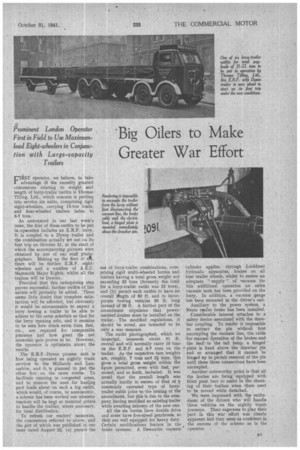Big Oilers to Make Greater War Effort
Page 19

If you've noticed an error in this article please click here to report it so we can fix it.
lk.ST operator, we believe, to take advantage 6f the recently granted concessions relating to weight and length of lorry-trailer outfits is Thomas Tilling, Ltd., which concern is putting into service six units, comprising rigid eight-wheelers, carrying 15-ton loads, and four-wheeled trailers laden to 6-7 tons.
As announced in our last week's issue, the first of these outfits to be put in. operation includes an E.R.F. lorry. It is coupled to a Dyson trailer and the combination actually Set out odits first trip on October 21, at the start of which the accompanying pictures were obtained by one of our staff photographers. Making up the fleet of sfi, there will be further E.R.F. eightwheelers and a number of A.E.C. Mammoth Major Eights, whilst all the trailers will be Dysons. Provided that this enterprising step proves successful, further outfits of like nature will probably be added. There seems little doubt that complete satisfaction will be afforded, but obviously it would be unreasonable to expect a lorry towing a trailer to be able to adhere to the same schedule as that for the lorry running solo, and it remains to he seen hciw much extra time, fuel, etc., are required for comparable journeys and how great the net economic gain proves to be. However, the operator is optimistic about the results.
The E.R.F.-Dyson pioneer unit is how being operated on nightly trunk services to the Midlands and Lancashire, and it is planned to put the other five on the same routes. To facilitate running in congested areas, and to remove the need for hauling part loads about on such a big outfit, which would, of course, be uneconomic, a scheme has been worked out whereby tractors will be keRt at terminal points to handle the trailers, where necessary, for local distribution.
To refresh our readers' memories, the concessions referred to above, and the gist of which was published in our issue dated August 22, (a) permit the use of lorry-trailer combinations, comprising rigid multi-wheeled lorries and trailers having a total gross weight not exceeding 32 tons (formerly the. limit for a lorry-trailer outfit was 22 tons), and (b) permit such outfits to have an overall ltngth of 60 ft. and to incorporate towing vehicles 30 ft. long instead of 26 ft. A further part of the amendment stipulates that powerassisted.brakes must be installed on the, trailer. The modified regulations, it should be noted, are intended to be only a war measure.
The outht photographed, which we inspected, measures about 51 ft. overall and will normally carry 15 tons on ,the E.R.F. and 6-7 tons on the trailer. As the respective tare weights are, roughly, 7 tons and 2i tons, this gives a total gross weight within the figure permitted, even with fuel, personnel, and so forth, included. It was noted that the overall length was actually hardly in excess of that of a commonly operated type of lorrytrailer outfit prior to the issuing of the amendment, but this is due to the company having modified an existing trailer while awaiting delivery of the new one.
All the six lorries have double drive and some have five-speed gearboxes, so they are well equipped for heavy duty. Certain modifications feature in the brake systems. A Dewandre vacuum cylinder applies, through Lockheed hydraulic apparatus, brakes on all four trailer wheels, whilst to ensure an adequate " supply " of vacuum for this additional operation an extra vacuum tank has been provided on the lorry. In addition, a vacuum gauge has been mounted in the driver's cab.
Auxiliary to the power system, a Neate taailer brake has been installed.
Considerable interest attaches to a safety device associated with the drawbar coupling. To render it impossible to extract the pin without first uncoupling the vacuum line, the cable 'for manual operation of the brakes and the lead—to the tail lamp, a hinged'
• plate is fixed above the drawbar pin and so arranged that it cannot he hinged zap to permit removal of the pin until these three connections have been uncoupled.
Another noteworthy point is that all the lorries are being equipped with front push bars to assist in the shunting of their trailers when these need to be moved while detached.
We were impressed with the enthusiasm of the drivers who' will handle these vehicle & on the nightly trunk journeys. Their eagerness to play their part in this war effort was clearly apparent and they seem as confident in the success of the scheme as is the operator.




















































